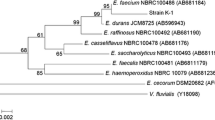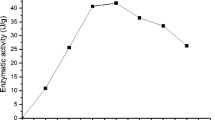Summary
A number of meso- and thermophilic anaerobic starch-degrading non-spore-forming bacteria have been isolated. All the isolates belonging to different genera are strictly anaerobic, as indicated by a catalase-negative reaction, and produce soluble starch-degrading enzymes. Compared to enzymes of aerobic bacteria, those of anaerobic origin mainly show low molecular mass of about 25 000 daltons. Some of the enzymes may have useful applications in the starch industry because of their unusual product pattern, yielding maltotetraose as the main hydrolysis product.
Similar content being viewed by others
References
Antranikian G, Herzberg C, Gottschalk G (1987a) Production of thermostable α-amylase, pullulanase and glucosidase in continuous culture by a new Clostridium isolate. Appl Environ Microbiol 53:1668–1673
Antranikian G, Zablowski P, Gottschalk G (1987b) Conditions for the overproduction and excretion of thermostable α-amylase and pullulanase from Clostridium thermohydrosulfuricum DSM 567. Appl Microbiol Biotechnol 27:75–81
Balch WE, Fox GE, Magrum LJ, Woese CR, Wolfe RS (1979) Methanogens — reevaluation of a unique biological group. Microbiol Rev 43:260–292
Bergmeyer HU, Grassl M (1983) Reagents for enzymatic analysis; enzyme-α-amylase. In: Bergmeyer HU (ed) Methods of enzymatic analysis, vol 2, 3rd edn. Verlag Chemie, Weinheim, pp 151–152
Brune G, Sahm H (1980) Methangärung zur Abwasserreinigung. In: Lafferty RM (ed) Fermentation. Springer, Berlin, Heidelberg, New York, pp 126–137
Essers L, Haralambie E (1977) Erfahrungen mit dem API 20A-Testsystem bei der Identifizierung von Anaerobiern aus der täglichen Routine. Zentralbl Bakteriol Hyg I Abt Orig A 238:394–408
Fogarty WM (1983) Microbial enzymes and biotechnology. Applied Science Publishers, London, pp 1–92
Jork H, Funk W, Fischer W, Wimmer H (1989) Dünnschichtchromatographie, vol 1a. VCH Verlag, pp 179–184
Koch R, Zablowski P, Antranikian G (1987) Highly active and thermostable amylases and pullulanases from various anaerobic thermophiles. Appl Microbiol Biotechnol 27:192–198
Madi E, Antranikian G, Ohmiya K, Gottschalk G (1987) Thermostable amylolytic enzymes from a new Clostridium isolate. Appl Environ Microbiol 53:1661–1667
Miller GL (1959) Use of dinitrosalicylic acid reagent for determination of reducing sugar. Anal Chem 31:426–428
Palla G (1981) C18-Reversed-phase liquid chromatographic determination of invert sugar, sucrose and raffinose. Anal Chem 53:1966–67
Street HV, Close JR (1956) Determination of amylase activity in biological fluids. Clin Chem Acta 1:256–268
Willstätter R, Waldschmidt-Leitz E, Hesse ARZ (1923) Über Pankreas-Amylase. Hoppe-Seyler's Z Physiol Chem 126:143–168
Zeikus JG (1979) Thermophilic bacteria: ecology, physiology and technology. Enzyme Microb Technol 1:243–252
Author information
Authors and Affiliations
Additional information
Offprint requests to: W. Trösch
Rights and permissions
About this article
Cite this article
Weber, H., Schepers, HJ. & Trösch, W. Starch-degrading enzymes from anaerobic non-clostridial bacteria. Appl Microbiol Biotechnol 33, 602–606 (1990). https://doi.org/10.1007/BF00172559
Received:
Accepted:
Issue Date:
DOI: https://doi.org/10.1007/BF00172559




